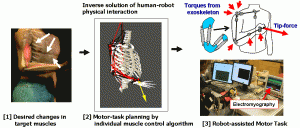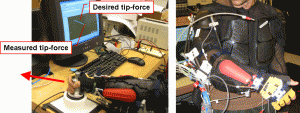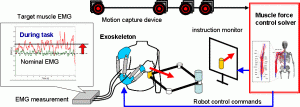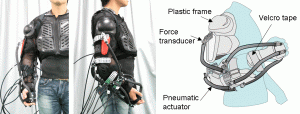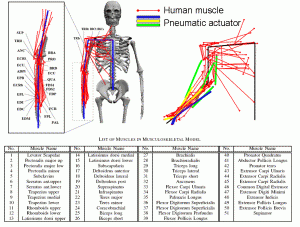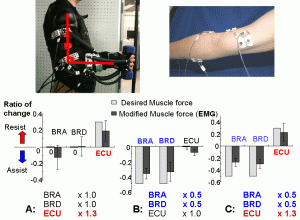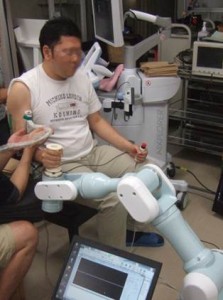Individual Muscle Control: Jun Ueda, Mechanical Engineering, Georgia Tech
| Individual Muscle Control using an Exoskeleton Robot |
| Location: Woodruff School of Mechanical Engieering, Georgia Institute of Technology |
| Members |
- Jun Ueda, Ph.D., Assistant Professor, Mechanical Engineering
- William Gallagher, Ph.D. Student, Robotics
- Vijaya Krishnamoorthy, Ph.D., PT, Assistant Professor, Rehabilitation Medicine, Emory University
- Minoru Shinohara, Ph.D., Associate Professor, Applied Physiology, Georgia Institute of Technology
- Ming Ding, Ph.D., Postdoctoral Fellow , Tokyo University of Science
- Ellenor Brown, , Ph.D. Student, Applied Physiology
- Yasuhide Yoshitake, Ph.D., National Institute of Sports and Fitness at Kanoya
- Tsukasa Ogasawara, Ph.D., Nara Institute of Science and Technology
- Atsutoshi Ikeda, Ph.D., Nara Institute of Science and Technology
- Yuichi Kurita, Ph.D., Hiroshima University
| Diagnosis of Neurological Movement Disorders using an Exoskeleton Robot |
| Computerized Motor Task Planning |
Due to the presence of muscle redundancy, joint-torques and muscle-forces are intricately coupled; this makes motor-task planning difficult and greatly limits the variety of function tests. By mathematically solving the joint torque-muscle force relationship using a musculoskeletal model, the algorithm systematically computes an adequate motor task that induces a desired muscle activation pattern in subjects.
The proposed motor-task planning for neuromuscular function tests computes an adequate magnitude and direction of a force that a subject must exert to induce a desired change in a target muscle force. An exoskeleton-type wearable robot is utilized to assist the change of joint torques. The overall system consists of a wearable actuator device, a handle, a muscle force control problem solver, a musculoskeletal human model, and a user-friendly graphical interface.
| Analytical Solution of Individual Muscle Control |
The individual muscle control by using an exoskeleton induces an arbitrary muscle activation pattern by mathematically solving the physical interaction at the level of individual muscles. The method is to solve not only a complex coupling between multiple muscles and joints but also the optimization principle in the neuromuscular system that coordinates redundant muscles. Preliminary results implied that muscle activities that may not be achieved in the standard exercise environment can be induced.
In the past two decades, a number of muscle-force prediction methods have been presented based on the optimization principle in the neuromuscular system. Static optimization method predicts redundant muscle forces by minimizing a physiology-based cost function, comprising the sum of muscular stress or force raised to a power, subject to force/torque constraints associated with a given task.
The individual muscle control is to solve the inverse problem of the aforementioned muscle force prediction. Note that this inverse solution is not straightforward since the induced muscle activation pattern must satisfy the physiology-based optimality criterion. Mathematically this problem can be regarded as a problem to determine adequate equality constraints (i.e., joint torques) for the physiology-based cost function such that the desired muscle forces are obtained as a result of the cost function minimization. Since one of the equality constraints is on joint torques, the use of an exoskeleton-type robot is essential to adequately assist/resist joint torques. Introducing Karush-Kuhn-Tucker (KKT) conditions provides conditions such that induced muscle forces do not violate the optimization principle in the neuromuscular system.
| Exoskeleton Robot |
The robot assists/resists 4 degrees of freedom (DOFs) in the human arm; 1 DOF for the flexion/extension of the elbow joint, 1 DOF for the supination/pronation of the forearm, and 2 DOF for the flexion/extension and adduction/abduction of the wrist joint, by using 8-10 pneumatic artificial actuators.
| Musculoskeletal Model |
An integrated human-exoskeleton model computes the interaction between the human muscle forces and torques generated by the robot. The integrated musculoskeletal model of the human upper-right limb calculates moment-arms from to each of the muscles to attached bones. This model consists of 5 rigid links with 12 joints corresponding to the waist, neck, shoulder, elbow, and wrist. Massless-wires model a total 51 muscles. The points of muscle attachment (origins and insertions) were determined based on anatomical data. A kinematic model of the exoskeleton that consists of pneumatic actuators and supporting frames was integrated with the human model. This model was created by Reishi Oya formerly at Nara Institute of Science and Technology, Japan.
| Experiments |
The robots used in this study include a wearable robotic exoskeleton and a robotic arm for subjects to grip. These robots applied forces and torques on the arm joints or hand of each subject while the subject held a given arm position. The forces and torques were chosen to induce specific activity in target muscle as predicted by a mathematical muscle model. A variety of elbow and wrist muscles were targeted and simultaneously controlled. To verify how well the robots controlled target muscle activity, we monitored electromyography (EMG) and ultrasound elastography (measurement of muscle stiffness using sound waves). Electrical activity and stiffness increase as the muscle contraction increases. The goals of this study were to develop and assess these new systems and to compare results obtained via EMG and elastography. Results show that the robotic systems were both able to induce general desired changes (increase, decrease or hold) in target muscle activity, but require further work to increase the precision of muscle activity control. We also found that elastography data was less variable than EMG and had a stronger linear relationship with changing force.
| Videos |
| Publications |
- Ellenor Brown, Kazuya Aomoto, Atsutoshi Ikeda, Tsukasa Ogasawara, Yasuhide Yoshitake, Minoru Shinohara, Jun Ueda, ” Comparison Of Ultrasound Muscle Stiffness Measurement And Electromyography Towards Validation Of An Algorithm For Individual Muscle Control,” 2013 ASME Dynamic Systems and Control Conference,(DSCC’13)
- Jun Ueda and Ming Ding, “Individual Control of Redundant Skeletal Muscles using an Exoskeleton Robot,” Redundancy in Robot Manipulators and Multi-Robot Systems,, Lecture Notes in Electrical Engineering, pp. 183-199, Vol. 57, Edited by Dejan Milutinovic and Jacob Rosen, ISBN 978-3-642-33970-7, Springer, 2013.
- William Gallagher, Ming Ding, Jun Ueda, “Relaxed Individual Control of Skeletal Muscle Forces via Physical Human-robot Interaction,” Multibody System Dynamics, Vol. 30, Issue 1, June 2013.
- Jun Ueda, Ming Ding, Vijaya Krishnamoorthy, Minoru Shinohara, Tsukasa Ogasawara, “Individual Muscle Control using an Exoskeleton Robot for Muscle Function Testing, ” IEEE Transactions on Neural and Rehabilitation Systems Engineering, Vol.18, No.4, pp.339-350, Aug. 2010.
[LINK (PubMed)] - Tsukasa Ogasawara and Jun Ueda, Chapter 7: Assistive device, Applications and Progress for Advanced Man-machine Interfaces and Information Technologies- “Neo-kaden” project in Keihanna Knowledge Cluster-, ISBN978-4-88231-999-3, in Japanese.
- Shinji Kuriyama , Ming Ding , Yuichi kurita , Jun Ueda and Tsukasa Ogasawara,”Flexible Sensor for McKibben Pneumatic Artificial Muscle,” International Journal of Automation Technology,Vol.3, No.6, pp. 731-740, 2009.[LINK (Fujipress IJAT)]
- Ming Ding, Yuichi Kurita, Jun Ueda, Tsukasa Ogasawara, ”
Pinpointed Muscle Force Control Taking Into Account the Control DOF of Power-assisting Device,” the 2010 Dynamic Systems and Control Conference (DSCC’10), Boston, MA, 2010. - Jun Ueda, Moiz Hyderabadwala, Vijaya Krishnamoorthy, Minoru Shinohara, “Motor Task Planning for Neuromuscular Function Tests using an Individual Muscle Control Technique,” 2009 IEEE 11th International Conference on Rehabilitation Robotics, Kyoto, Japan, June 2009.
- Jun Ueda, Moiz Hyderabadwala, Ming Ding, Tsukasa Ogasawara, Vijaya Krishnamoorthy, Minoru Shinohara, “Individual Muscle Control using an Exoskeleton Robot for Muscle Function Testing, ” the 2009 Dynamic Systems and Control Conference (DSCC’09) , Hollywood, California, October 12-14, 2009.
- Ming Ding, Jun Ueda, Tsukasa Ogasawara, “Pinpointed Muscle Force Control Using a Power-Assisting Device: System Configuration and Experiment,” The 2nd IEEE / RAS-EMBS International Conference on Biomedical Robotics and Biomechatronics (BioRob 2008).
- Jun Ueda, Masayuki Matsugashita, Reishi Oya, and Tsukasa Ogasawara, “Control of Muscle Force During Exercise Using a Musculoskeletal-Exoskeletal Integrated Human Model,” Experimental Robotics, The 10th International Symposium on Experimental Robotics, Springer Tracts in Advanced Robotics, ISBN:978-3-540-77456-3,pp. 143–152, Volume 39, 2008.
- Jun Ueda, Ming Ding, Masayuki Matsugashita, Reishi Oya, Tsukasa Ogasawara “Pinpointed control of muscles by using power-assisting device,” Proceedings of the 2007 IEEE International Conference on Robotics and Automation (ICRA 2007), pp. 3821-3828, Roma, Italy, April, 2007.
| Patent |
- Driving force calculating device, driving force calculating method, power assisting device, driving force calculating program, and computer-readable storage medium, United States Patent 7529632, Publication Date: 05/05/2009
| Funding |
- National Science Foundation-Japan Science and Technology Agency (NSF-JST) Strategic Cooperative program in Robotics, Joint Research Program for Innovative Rehabilitation Support Technology Based on Fusion of Engineering, Medical, and Physiological Sciences (US side PI: Ueda, Japan side PI: Ogasawara), 04/2010-09/2012 (Link to JST).
- Georgia Tech/Emory Healthcare system institute Seed grant program, Extracting Impaired Modulation of Muscle Activation Pattern in Neurological Patients Using Pinpointed Muscle Control Robot, PI: Ueda, co-PIs: Shinohara, Krishnamoothy, $50000, 09/01/2008-06/30/2009 (completed) (Link to HSI)
- National Science Foundation, Division of Information & Intelligent Systems, EAGER: Muscle Adaptation Induced by the Physical Interaction with an Exoskeleton and its Application to Motor-Task Planning for Neurorehabilitation (#1142438), PI: Ueda and co-PI Shinohara, $49863, 09/01/2011-08/31/2013 (Link to Award #1142438)
| Contact address |

